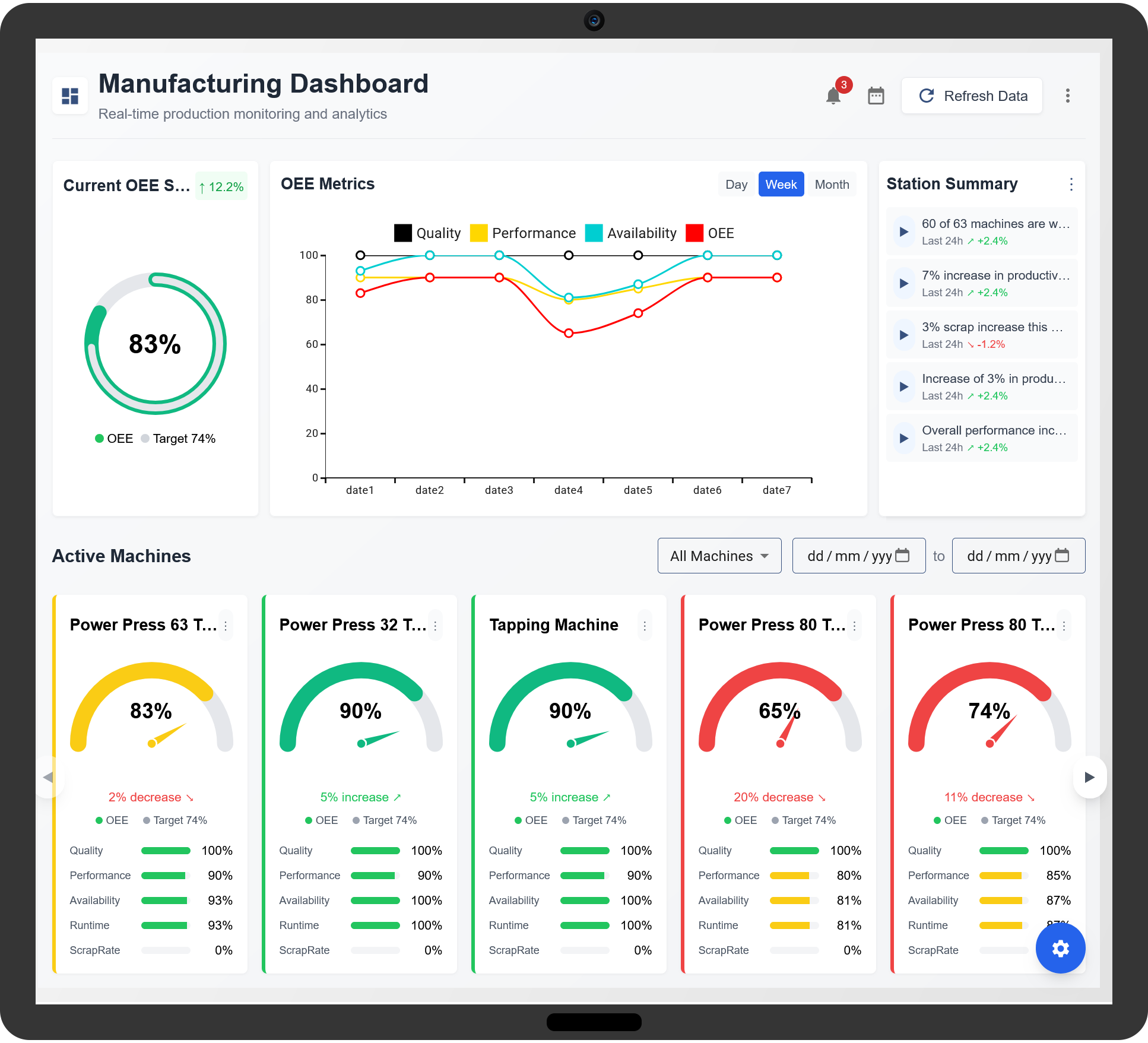Overall Equipment Effectiveness (OEE) is a key metric used in manufacturing to measure the efficiency of equipment and production processes. A higher OEE indicates better utilization of resources, reduced downtime, and improved productivity. Increasing OEE requires a strategic approach, focusing on availability, performance, and quality improvements. By implementing best practices, manufacturers can enhance operational efficiency and achieve higher output with minimal waste.

1. Understanding OEE Components
OEE is calculated using three key factors:
- Availability: The percentage of scheduled production time that equipment is available for operation.
- Performance: The speed at which equipment operates compared to its maximum potential speed.
- Quality: The percentage of defect-free products produced.
The formula for OEE is:
OEE (%) = Availability × Performance × Quality
To improve OEE, each of these factors must be optimized.
2. Reducing Unplanned Downtime
Equipment downtime significantly impacts availability. Reducing both planned and unplanned downtime is crucial for improving OEE.
- Implement Preventive Maintenance: Regular maintenance schedules help prevent unexpected breakdowns.
- Use Predictive Maintenance: Monitoring equipment conditions in real-time allows early detection of potential failures.
- Optimize Changeovers: Reducing setup time between production runs increases machine availability.
3. Enhancing Equipment Performance
Maximizing machine performance ensures that production runs at optimal speeds without unnecessary slowdowns.
- Monitor Machine Speed: Identify and address factors causing slow cycles.
- Reduce Micro-Stoppages: Address frequent small interruptions that impact performance.
- Upgrade Equipment: Ensure machines are capable of handling higher speeds efficiently.
4. Improving Product Quality
Defects and rework reduce OEE by increasing waste. Improving quality ensures more defect-free products.
- Enhance Quality Control: Implement strict inspection processes to identify defects early.
- Train Operators: Skilled operators are less likely to make errors that lead to defects.
- Use Automation: Automated systems can reduce human errors and improve consistency.
5. Optimizing Production Scheduling
Effective scheduling ensures that production runs smoothly without unnecessary delays.
- Balance Workloads: Distribute production evenly to avoid overloading specific machines.
- Use Real-Time Monitoring: Track production progress and adjust schedules as needed.
- Minimize Idle Time: Ensure that machines and operators are fully utilized.
6. Utilizing Data Analytics
Data-driven decision-making helps identify areas for OEE improvement.
- Analyze Performance Trends: Use historical data to find patterns affecting OEE.
- Identify Bottlenecks: Detect issues slowing down production.
- Implement Continuous Improvement: Regularly refine processes based on data insights.
7. Employee Engagement and Training
Engaged and well-trained employees play a crucial role in improving OEE.
- Provide Regular Training: Educate workers on best practices and new technologies.
- Encourage Team Collaboration: Teams working together can solve problems faster.
- Recognize Achievements: Rewarding employees for improvements boosts motivation.
8. Future of OEE Improvement
With advancements in technology, OEE improvement strategies continue to evolve.
- AI-Powered Maintenance: AI predicts equipment failures before they occur.
- IoT-Enabled Monitoring: Sensors provide real-time insights into machine performance.
- Automation Integration: Robotics and automation reduce errors and increase efficiency.
By implementing these strategies, manufacturers can increase OEE, improve productivity, and maintain a competitive edge in the industry.
How to increase OEE in manufacturing?
What is OEE in manufacturing?
OEE (Overall Equipment Effectiveness) is a key metric that measures manufacturing productivity by evaluating availability, performance, and quality.
Why is improving OEE important?
Improving OEE helps reduce waste, increase efficiency, lower costs, and maximize equipment utilization in manufacturing.
What are the key components of OEE?
The three key components of OEE are availability (uptime vs. downtime), performance (actual speed vs. ideal speed), and quality (good parts vs. defective parts).
How does reducing downtime improve OEE?
Reducing downtime increases machine availability, which directly improves OEE by ensuring maximum production uptime.
What role does preventive maintenance play in OEE improvement?
Preventive maintenance helps avoid unexpected breakdowns, ensuring machines run smoothly and improving overall availability.
How can real-time monitoring enhance OEE?
Real-time monitoring provides live data on equipment performance, enabling quick response to issues that could impact OEE.
What impact does production scheduling have on OEE?
Effective production scheduling minimizes idle time and ensures optimal machine utilization, improving OEE.
How does reducing cycle time increase OEE?
Reducing cycle time increases production speed, improving performance efficiency and enhancing OEE.
What are the best practices for minimizing defects in manufacturing?
Best practices include root cause analysis, process standardization, and quality control measures to improve OEE.
How can workforce training improve OEE?
Proper training helps operators run machines efficiently, reduce errors, and minimize downtime, leading to better OEE.
What is the role of automation in OEE improvement?
Automation reduces manual errors, improves consistency, and enhances production efficiency, contributing to higher OEE.
How can predictive maintenance help achieve higher OEE?
Predictive maintenance uses data analytics to predict failures before they occur, reducing downtime and improving OEE.
What strategies help eliminate minor stops in production?
Strategies include regular machine inspections, better workflow organization, and implementing automated alerts for quick response.
How does optimizing changeover time affect OEE?
Reducing changeover time increases machine availability, allowing more production cycles and improving OEE.
What are the long-term benefits of improving OEE?
Higher OEE leads to increased productivity, cost savings, improved product quality, and a more competitive manufacturing process.